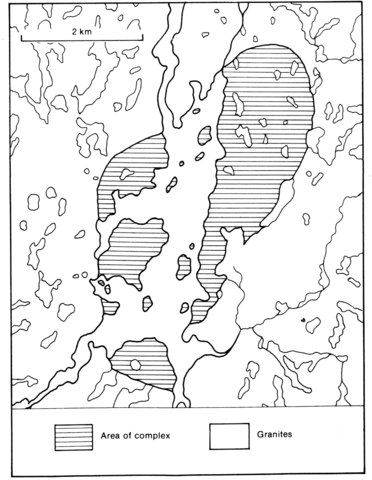stripes
An oval body of about 8x4 km, Bigspruce Lake is emplaced in Precambrian equigranular and porphyritic biotite granites. Almost all of the complex is now covered by the waters of Bigspruce Lake because of a power dam built on the Snare River. The internal structure of the complex is unknown but it includes ijolite, ultramafic rocks, syenite and carbonatite. The ultramafics are essentially amphibolite with up to 50% magnetite, other opaque minerals, and a little apatite, carbonate and possible altered feldspar. Nepheline syenite contains perthite, nepheline, aegirine/aegirine-augite, bluish amphibole, biotite, sodalite, which forms conspicuous bright blue veins on some outcrops, zeolite, carbonate, sphene, apatite and opaques. A syenite with sodic amphibole and pyroxene, biotite and a little quartz is described as nordmarkite by Lord (1942, p. 35), but may be fenite. Leech et al. (1963, p. 60) describe a gradation from nepheline syenite, through syenite and quartz syenite to granite. Ijolites comprise approximately equal proportions of nepheline and aegirine with a little biotite, sodalite and carbonate. A body of white, banded limestone, undoubtedly carbonatite, occurred on the original northwest shore of the Lake with purple fluorite concentrated at its margin.
CURRIE, K.L. 1976a. The alkaline rocks of Canada. Bulletin, Geological Survey of Canada, 239: 1-228.
LEECH, G.B., LOWDON, J.A., STOCKWELL, C.H. and WANLESS, R.K. 1963. Age determinations and geological studies. Paper, Geological Survey of Canada, 63-17: 1-140.
LORD, C.S. 1942. Snare River and Ingray Lake Map-Areas, Northwest Territories. Memoir, Geological Survey of Canada, 235: 1-55.

